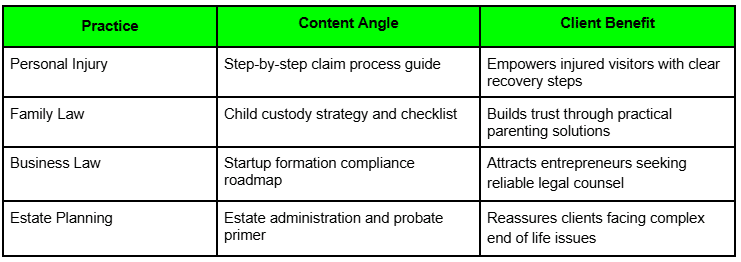
A law firm’s blog that publishes high-value content can generate 97 percent more backlinks and see 434 percent more indexed pages, transforming online visibility into new case inquiries. In this guide, you’ll discover proven legal blog ideas that attract clients quickly.
This includes practical writing and SEO techniques to convert readers into leads, promotion strategies to maximize reach, advanced AI and entity-SEO enhancements. We will cover content mapping across the client journey, niche topics for hyper-targeted audiences, and answers to the most common questions law firms ask about blogging.
By following these tactics and supplementing your strategy with Forward Lawyer Marketing’s expert law firm blog marketing services, your practice can accelerate caseload growth and revenue.
A law firm’s blog can significantly improve online visibility. High-value content can generate more backlinks and increase indexed pages, which can lead to more case inquiries.
This information supports the article’s claim about the benefits of legal blogging.
Legal blog ideas are topical angles that address client needs and position your firm as a trusted advisor; by focusing on practice-area expertise, actionable guidance, and social proof, you generate qualified leads through authoritative content. Below is a table of high-impact blog categories structured to spark client interest and demonstrate your capabilities.

Each category leverages targeted topics to showcase your legal expertise and drive potential clients toward contact forms or consultation calls.
Core practice areas with consistent search demand include personal injury, family law, business law, estate planning, and real estate. By selecting areas where your firm has proven success, you align content with client intent and demonstrate authority.
Focusing on these niches ensures your blog ideas resonate with active searchers and highlight your firm’s proven track record.
Personal injury topics convert when they offer clarity on complex processes.
These content angles provide value before conversion, encouraging visitors to request your guidance on their specific claims—and they lay the groundwork for next-level promotional tactics.
Family law readers seek both legal knowledge and emotional reassurance.
By combining legal insight with empathetic guidance, your firm becomes the go-to resource for sensitive family matters and fosters trust that leads to consultations.
Entrepreneurs and business owners search for actionable legal roadmaps.
These focused, practical topics attract decision-makers ready to engage your firm for tailored legal services and premium support.
Writing legal blog posts that convert begins with clear definitions, a logical structure, and a compelling call to action; by integrating SEO, persuasive storytelling, and social proof, you transform readers into leads. Below are best practices refined through Forward Lawyer Marketing’s consultative approach to content creation.
Optimized legal blogs rank higher when they follow on-page SEO principles:
Optimized legal blogs rank higher when they follow on-page SEO principles. This includes conducting keyword research, incorporating practice-area entities and synonyms, using schema.org markup, and linking internally to service pages.
This citation supports the article’s discussion of SEO best practices for law firm blogs.
Consistent application of these techniques drives visibility and positions your blog as an authoritative resource.
Compelling titles combine specificity and urgency—for example, “5 Essential Steps After a Car Crash to Maximize Your Settlement.” Introductions should define the topic, explain why it matters, and preview actionable takeaways. A strong opening might read: “After a collision, timely legal action can double your compensation; here’s how you can navigate the claims process effectively.” Engaging hooks like statistics or questions immediately connect with readers’ concerns and set expectations for valuable insights ahead.
Case studies and client testimonials build trust by illustrating your firm’s real-world success; they demonstrate expertise and empathy through concrete examples. Present anonymized narratives that highlight the challenge, your strategic approach, and quantifiable results (e.g., “a $250,000 settlement obtained in six weeks”). Embedding quotes or video snippets from satisfied clients adds social proof that encourages new visitors to reach out.
Consistency in publishing fosters audience engagement and search engine favor. Aim for at least two high-quality blog posts per month, balancing evergreen topics (e.g., “Understanding Probate Laws”) with timely content (e.g., “New Employment Regulations 2025”). Regular updates sustain reader interest and signal to search engines that your site remains active and relevant, setting the stage for improved rankings and lead generation.

Promoting legal blogs requires a multichannel approach that leverages social platforms, email outreach, analytics, and targeted ads; by aligning promotion with content themes and audience behavior, you extend reach and accelerate client inquiries.
Social media platforms amplify blog visibility when you tailor posts to each channel’s audience. Share concise video summaries on LinkedIn, client success snapshots on Facebook, and quick legal tips on Twitter. Use branded hashtags like #LawTips2025 and encourage shares by posing questions or polls. Consistent engagement and platform-specific adaptation help direct interested prospects back to your blog and service pages.
Email newsletters convert subscribers into consultations by delivering curated blog content directly to inboxes. Segment your list by practice area interest—such as personal injury or family law—and send targeted recommendations like “Top 3 Steps After a Workplace Injury.” Include clear calls to action, for example, “Schedule a free case evaluation,” to guide readers toward booking a consultation with your firm.
Measuring ROI hinges on tracking lead generation metrics and conversion data. Key performance indicators include:
By linking analytics data to revenue outcomes, you demonstrate the impact of your blogging efforts on caseload expansion and firm profitability.
Effective analytics and lead-tracking tools include Google Analytics 4 for traffic and behavior analysis, Google Search Console for search query insights, and CRM platforms like HubSpot or Clio Grow to attribute inquiries to specific blog posts. SEMrush or Ahrefs can monitor keyword rankings and backlink profiles, ensuring you refine content based on performance and competitive benchmarks.
Advanced tactics such as entity-based SEO and AI-powered content generation deepen semantic relevance and streamline topic ideation; by adopting these technologies, law firms can produce authoritative, data-driven blogs at scale.
Entity-based SEO organizes content around defined legal concepts—such as “probate administration” or “mediation process”—rather than isolated keywords. By linking entities through semantic triples (e.g., “Probate administration → involves → filing court documents”), your blog signals clear topical relationships to search engines, improving contextual understanding and increasing the likelihood of rich results.
AI platforms can analyze search trends, competitor coverage, and client FAQs to propose blog topics tailored to your practice areas. They can draft initial outlines, suggest relevant entities, and optimize on-page SEO by recommending headers, meta descriptions, and keyword placements. When paired with expert legal review, AI accelerates content production without sacrificing accuracy or authority.
Implement , , , and schema where appropriate. For step-by-step guides, wrap procedure steps in properties. Mark client question sections with and entities. This structured data enhances eligibility for featured snippets, PAA carousels, and rich result formats, driving higher click-through rates and improved search presence.
Maintaining trust and compliance requires transparent AI use. Always disclose AI-assisted drafting, ensure content undergoes attorney review, and verify legal accuracy before publication. Protect client confidentiality by anonymizing case details and securing necessary permissions. By upholding ethical standards, your firm reinforces credibility and avoids potential malpractice concerns.
Mapping blog topics to awareness, consideration, and conversion stages guides prospects smoothly toward retention; targeted content at each phase fosters trust and motivates action.
Early-stage readers seek foundational explanations. Create “What Is a Personal Injury Lawsuit?” posts that define key terms, outline typical timelines, and introduce your firm’s support services. Educational guides establish your practice as a reliable source for general legal information.
Mid-funnel prospects compare options. Publish “5 Questions to Ask a Family Law Attorney Before Hiring” articles and “Case Study: Successful Workplace Injury Settlement” analyses. These pieces showcase expertise, highlight results, and provide decision-making criteria.
Bottom-funnel topics directly prompt action. Develop “Schedule Your Free Consultation for Estate Planning” pages with embedded contact forms and clear outlines of your firm’s process. Use compelling case summaries and testimonials to reassure prospects of your capabilities and drive inquiries.
Local targeting involves embedding geographic entities—such as city names, county courthouses, and regional regulations—throughout your content. Write “New York Slip-and-Fall Laws by Borough” or “California Probate Timeline for Los Angeles Residents” posts. Include Google My Business citations and schema to strengthen visibility in local search results and attract clients within your service area.
Topics like “Legal Implications of AI-Generated Contracts” or “Regulations for Cryptocurrency Estate Planning” position your firm at the forefront of innovation. Early coverage captures search interest and establishes thought leadership.
For unique niches such as aviation law or elder abuse advocacy, focus on “FAA Litigation Process Explained” or “Protecting Seniors From Financial Exploitation” guides. Detailed, specialist content signals deep expertise that attracts clients with complex needs.
Tie blog content to events such as “Tax Law Updates Before April 15” or “Estate Planning Tips for Year-End Financial Planning.” Seasonal themes resonate with timely search queries and prompt immediate engagement.
Weave anonymized case narratives into specialized topics. For example, “How We Secured a Historic Aviation Liability Settlement” illustrates your firm’s results and lends credibility to technical subject matter, persuading niche clients to reach out.
Legal blogs often raise questions about effectiveness, strategy, and ROI; addressing these concerns directly demonstrates your firm’s expertise and guides prospective clients toward informed decisions.
Lawyers attract clients by publishing content that answers specific legal questions—such as “How to File a Personal Injury Claim”—and by optimizing posts for search intent, social sharing, and clear calls to action that invite readers to schedule consultations.
A lawyer’s blog should cover practice-area FAQs, step-by-step guides, case study summaries, and local legal updates, ensuring each post aligns with client pain points, search demand, and conversion goals.
Blogging remains highly effective for law firms, with content marketing generating more leads than traditional methods and costing less. When optimized for entity-SEO and rich results, blogs continue to drive traffic and client inquiries.
Blogging remains highly effective for law firms, with content marketing generating more leads than traditional methods and costing less. When optimized for entity-SEO and rich results, blogs continue to drive traffic and client inquiries.
This citation supports the article’s assertion that blogging is still effective for law firms.
A robust strategy combines keyword research, entity clustering by practice area, scheduled publishing, promotional tactics across social and email, and ongoing performance analysis to refine topics and maximize lead generation.
Engaging clients through legal blogging requires a blend of targeted ideas, persuasive writing, strategic promotion, and advanced SEO practices. By implementing these comprehensive tactics—and leveraging Forward Lawyer Marketing’s tailored law firm blog marketing services—your firm can accelerate caseload growth, boost revenue, and establish lasting authority in your practice areas.
At FORWARD Lawyer Marketing we believe in taking a “leave no stone unturned” approach when it comes to our legal clients. With that in mind, we employ extremely experienced people in the industry. Our SEO Director has been marketing online for well over two decades and oversees all SEO tasks including editing content and performing on-page optimization as well as internal and external linking.
Our specialty is law firm marketing and SEO for lawyers at FORWARD Lawyer Marketing, contact us for a free site review and consultation at (888) 590-9687 to discuss how we can increase the revenue of your law firm.